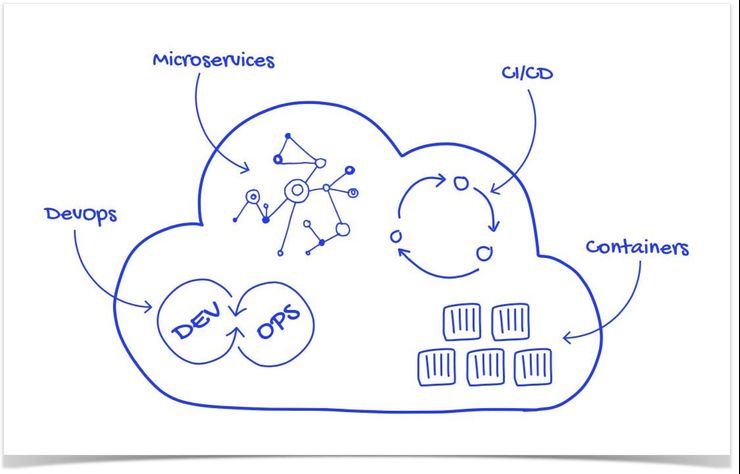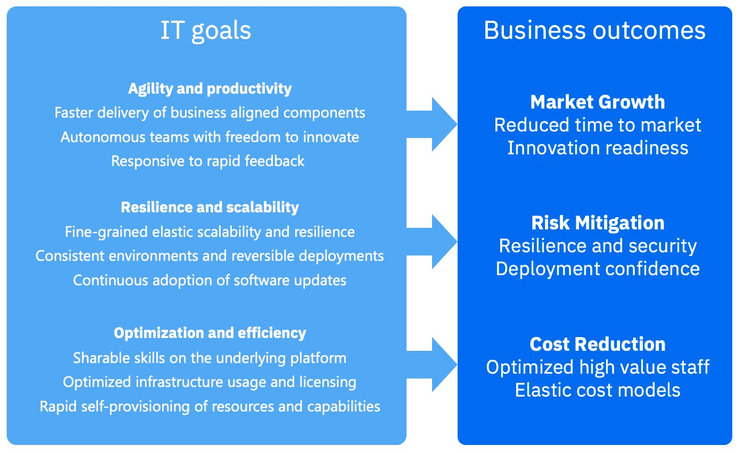Cloud App Development: Using Cloud-Native Principles to Build Solutions
Before Covid-19, the adoption of cloud technologies was on the rise. After the pandemic hit, this adoption accelerated even more. By 2026, it's estimated that the cloud will store more than 100 billion terabytes of data, and the global market will be worth US$947 billion — both impressive figures there’s little reason to doubt.
Cloud-powered companies such as Airbnb, Netflix, and Uber are reinventing and dominating their industries, and other businesses are relying more on cloud-powered software to stay competitive.
According to a 2021 State of the Cloud report by Flexera, 70% of leading European cloud initiatives are “migrating more workloads to the cloud” others are optimising their existing use of cloud technologies for cost savings, and 50% are prioritising a cloud-first strategy.
Despite the strategic advantages migrating to the cloud offers, many companies still have a rudimentary understanding of cloud-native app development and cloud tech principles.
MadAppGang provides cloud app development services, and we know how crucial it is to understand the cloud-native approach before building a cloud app or migrating your existing software to the cloud. This article aims to help your business take full advantage of all the possibilities cloud technology offers. To start, let's clarify what cloud apps are and look at the benefits and main principles of creating a cloud-based app.
What are cloud apps?
When we describe an app as “cloud” or “cloud-native” we’re referring to how it is developed and deployed rather than where it's hosted. The hallmark of cloud solutions is that they’re created with microservices architecture, but this isn’t the whole story. The notion of cloud-native covers an approach to designing and delivering software that reaps all the conveniences of the cloud: scalability, flexibility, high performance.
There are four basic linchpins in cloud-native technologies: microservices, containers and orchestration, continuous delivery (СD), and DevOps. Let’s see what they are:

Source: Medium
- Microservices is an architectural approach that involves arranging an application as a collection of small, independent services that run independently and communicate over application programming interfaces (APIs).
- Containers are small microservices packages that help server virtualisation. They are easy to handle when they come in a small number. However, an app can contain dozens or even hundreds of containers. For such cases, special container orchestration tools come in handy as they automate management of all of them.
- Continuous delivery (CD) refers to the automation of as many processes (such as tests) as possible. This helps to quickly and reliably deliver code changes from developers’ desktops to production.
- DevOps refers to the collaboration between software developers and IT operations. DevOps' goal is to automate and shorten software delivery and infrastructure changes and ensure continuous delivery.
The benefits of a cloud app
The cloud-native approach seems complicated at first glance. In some ways, it is. For successful cloud app development, you should follow certain patterns, change your mindset when it comes to software development, and find an experienced team. This requires time and effort. However, the benefits you get from building a cloud-native app far outweigh the negatives. Let’s have a quick view at the business advantages of developing cloud-native software:
- Flexibility and scalability – You can easily scale your app up and down. Thus, the number of servers handling the solution can be increased during periods of peak demand and decreased during periods of low demand.
- Mobility – Your app can be moved from one cloud to another (for example, from AWS to Google Cloud or Azure) with minimal effort. It’s also possible to store the app's microservices in different clouds if needed.
- Recovery and backup – Cloud-based software eliminates the need to build and configure expensive backup and recovery systems, as many cloud vendors offer backup and fast disaster-recovery solutions.
- Ease of management – By adopting cloud-native technology, infrastructure management becomes simpler. Serverless platforms, such as AWS Lambda and Azure Function, relieve companies from having to perform operations such as configuring networks, allocating storage and provisioning cloud instances.
- Agility – The cloud-native approach helps development and operational teams work seamlessly and simultaneously on different parts (microservices) of a product. Deployment, upgrades, and rollouts are easy and efficient thanks to the smooth cooperation, highly automated processes, and the standardisation of routine tasks.
- Cost savings – Most cloud vendors charge for compute instances by the minute. This means you only pay for the services in use (not a whole bundle of services) and only when you use them. As a result, you have an easy-to-scale solution, which is also very cost-effective to maintain. In addition, updating certain functionalities doesn’t affect the entire cloud application, preventing you from losing money while the service is down.

Cloud-native advantages. Source: Medium
5 Key principles for cloud app development
As mentioned earlier, microservices architecture is the defining characteristic of cloud-native apps. And as cloud-native architecture involves adapting to many new possibilities, merely creating a microservices-based architecture isn’t enough to build cloud-native applications.
If you want to design an app that fully uses the cloud and avoids the pitfalls of other software development approaches, you'll need to follow certain cloud application development principles. These five key principles will guide you:
Design for automation
Automated solutions require larger investments, but this generally pays off in terms of ongoing effort and system performance. With automated processes, you can repair, scale, and deploy an app much faster. The key is to instrument the system so it generates meaningful logs and events, which can be used as hooks to automate activities. When developing a cloud app, make sure that the system can automatically handle the following:
- Setting up infrastructure, such as machine instances.
- Building, testing and deployment in the continuous integration and continuous delivery (CI/CD) pipeline.
- The app's ability to scale up or down in response to changes in load.
- Recovery from failure, health monitoring, and backup.
Use stateless components
It can be challenging to avoid storing 'state' (for instance, user data such as items in shopping carts, or system state) in real-world production. However, it's difficult to manage the state in distributed applications. That's why it's better to develop a cloud app while heeding how and when you store state, and use stateless components wherever you can. Stateless components also benefit your software in various ways, making it easy to scale, repair, roll back, and balance loads.

In-depth security
For cloud app development, the defence-in-depth approach is recommended. This means that software is built assuming that none of the components can be trusted. The app's design should aim at hardening all components, encrypting data and applying authentication between all components, so there is no 'inside' and 'outside.'. The defence-in-depth approach allows you to build a resilient app, and gives you the flexibility to deploy components in untrusted environments.
You can also use the Identity and Access Management (IAM) of your cloud vendor to manage resource permissions with a high level of automation and minimal hassle. For example, if you use Amazon Cloud, you can use its IAM to securely provide credentials for services that run on Amazon Elastic Compute Cloud (EC2), Amazon DynamoDB and others. Thus, it becomes impossible to hack passwords as they don't exist.
Give preference to managed services
Cloud vendors such as AWS, Azure or Google Cloud provide a wide variety of managed services that remove the headache of managing the backend software or infrastructure. There is a concern about taking advantage of these services and tools because enterprises are concerned about being 'locked in' to a given provider. In practice, however, the potential cost benefits of migrating to another cloud don't outweigh the significant time and effort savings you get when a trusted cloud provider manages your service at scale.
You've probably already heard about Vault, a service for data protection, Podman, a container engine, Istio, a service mesh, and others. These all are useful instruments but in most cases, you don't need to pay for them as they’re redundant. Normally, you can get all the necessary tools and beyond from your cloud vendor.
For instance, installing and configuring Kubernetes is a tedious process, and running containers in production is even more demanding. So, if you plan to store your app on Google Cloud Platform, it's better to use Google Kubernetes Engine (GKE) rather than just Kubernetes. GKE provides all Kubernetes functions — load balancing, automatic upgrades, node auto-repair, and others — but these functions are managed automatically or by the provider.
Constant improvement
When planning your cloud app development, remember that building innovative software isn’t enough; you have to keep up with new technologies and trends to remain competitive. You should always aim to improve and upgrade your app’s architecture as your business requirements, cloud provider offerings, and customer needs change. While this requires investments, it enables a fast and efficient response to the ever-changing environment.
Final word
Adopting the cloud-native approach brings lots of benefits to your business: flexibility, agility, cost-efficiency, and many others. Your business can become more efficient, offer better service, and grow smoothly. However, it's critical to understand that cloud-native is not only a different approach to designing and architecting applications, but also to organising business processes.
Cloud app development follows the core principles that came from pioneer companies' experiences, challenges, and failures. These principles can serve as a guide to ensure you avoid the mistakes of the past while getting all the benefits of the cloud. It is, however, best to rely on the expertise of specialists in this case, as cloud-native development is not as simple as it may seem.
If you haven't grown your cloud development team yet, trust your project to MadAppGang. With our experienced and skilled specialists, we can design and build both mobile and web apps that are cloud-native. Our team is ready to handle your project, no matter how complicated it is. Contact us and let's breathe life into your idea together.
